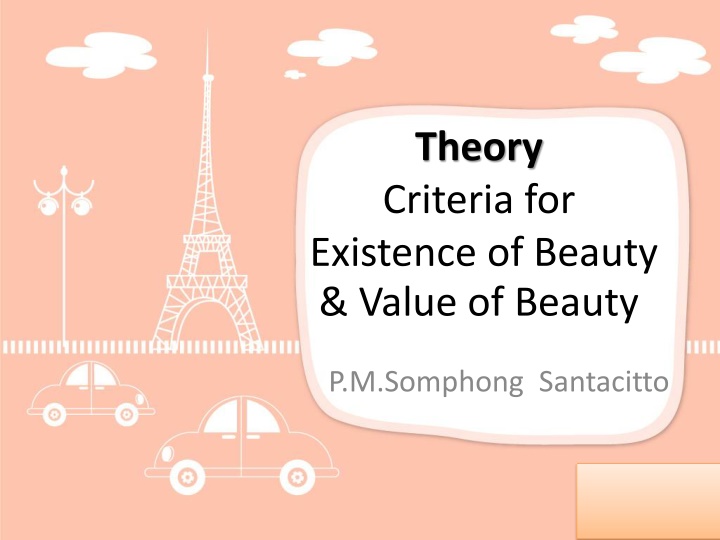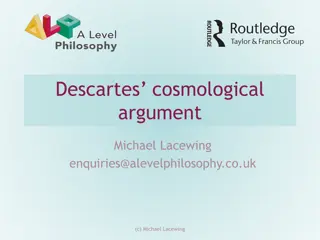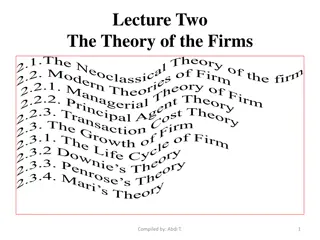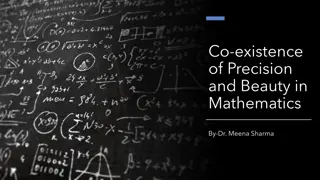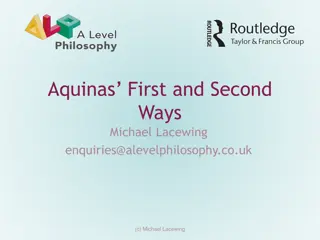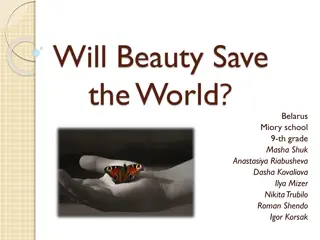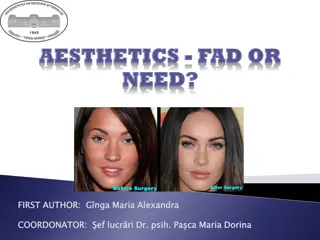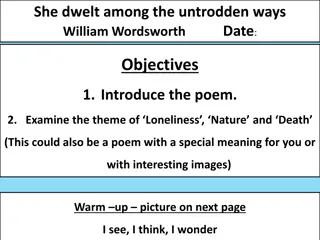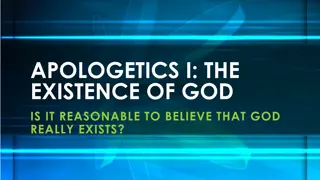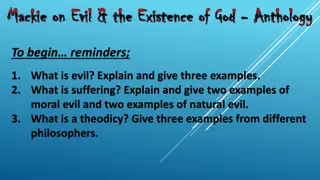The Theory of Beauty and Criteria for Existence
Understanding the criteria for the existence of beauty encompasses different philosophical perspectives such as Materialism, Idealism, and Dualism. Materialism posits that everything is composed of material, while Idealism asserts that reality is fundamentally mental or immaterial. The debate on the existence of beauty delves into metaphysical questions about the nature of reality and human perception.
Download Presentation

Please find below an Image/Link to download the presentation.
The content on the website is provided AS IS for your information and personal use only. It may not be sold, licensed, or shared on other websites without obtaining consent from the author.If you encounter any issues during the download, it is possible that the publisher has removed the file from their server.
You are allowed to download the files provided on this website for personal or commercial use, subject to the condition that they are used lawfully. All files are the property of their respective owners.
The content on the website is provided AS IS for your information and personal use only. It may not be sold, licensed, or shared on other websites without obtaining consent from the author.
E N D
Presentation Transcript
Theory Criteria for Existence of Beauty & Value of Beauty P.M.Somphong Santacitto
criterion for existence of beauty
What is criterion for existence of beauty? Where is position of beauty? Existence of beauty depends on individual philosophy esp. metaphysics. Materialism, Idealism, Dualism each has detailed description. Question on existence of beauty is about metaphysics philosophy on talks that what the earth is existence.
3 criteria for existence of beauty 1.Materialism 2.Idealism 3.Dualism
1. Materialism In philosophy, the theory of materialism holds that all things are composed of material, and that all emergent phenomena (including consciousness) are the result of material properties and interactions. In other words, the theory claims that our reality consists entirely of physical matter that is the sole cause of every possible occurrence, including human thought, feeling, and action. Materialism is typically considered to be closely related to physicalism; although, to some philosophers, materialism is synonymous with physicalism. Contrasting philosophies include idealism and other forms of monism, dualism, and pluralism.
Conclusion Asserts: Thing exists is material or matter, this is perceived by 5 senses, this reject all values, whether it be good or beauty and if so, it is convention made that it exists. Beauty depends on valuing it. Beauty is not in material or things in the world are made by feeling of like or dislike i.e. beauty of things depend on human. If non, no beauty exists due to own satisfaction, beauty is not material, but human heart, criteria for beauty is not eternal to individual feelings or taste.
2. Idealism In philosophy, idealism is the group of philosophies which assert that reality, or reality as we can know it, is fundamentally mental, mentally constructed, or otherwise immaterial. Epistemologically, idealism manifests as a skepticism about the possibility of knowing any mind-independent thing. In a sociological sense, idealism emphasizes how human ideas especially beliefs and values shape society. As an ontological doctrine, idealism goes further, asserting that all entities are composed of mind or spirit. Idealism thus rejects physicalist and dualist theories that fail to ascribe priority to the mind.
The earliest extant arguments that the world of experience is grounded in the mental derive from India and Greece. The Hindu idealists in India and the Greek Neoplatonists gave panentheistic arguments for an all-pervading consciousness as the ground or true nature of reality. In contrast, the Yog c ra school, which arose within Mahayana Buddhism in India in the 4th century CE, based its "mind-only" idealism to a greater extent on phenomenological analyses of personal experience.
This turn toward the subjective anticipated empiricists such as George Berkeley, who revived idealism in 18th-century Europe by employing skeptical arguments against materialism. Beginning with Immanuel Kant, German idealists such as G. W. F. Hegel, Johann Gottlieb Fichte, Friedrich Wilhelm Joseph Schelling, and Arthur Schopenhauer dominated 19th-century philosophy. This tradition, which emphasized the mental or "ideal" character of all phenomena, birthed idealistic and subjectivist schools ranging from British idealism to phenomenalism to existentialism. The historical influence of this branch of idealism remains central even to the schools that rejected its metaphysical assumptions, such as Marxism, pragmatism and positivism.
Conclusion Asserts: Mind or spirit and material exist, but that spirit plays important role in the material world and value of existent good and beauty, not made, thus, beauty exists in nature or material or external world. For patterns of beauty in material, human functions to search for pattern or beauty and who has done so is called an artist and criteria for beauty is not eternal due to beauty in material. Even humans do not perceive, beauty of material is free from our judgment.
3. Dualism 1. Dualism (from the Latin word duo meaning "two") denotes a state of two parts. 2. The term 'dualism' was originally coined to denote co-eternal binary opposition, a meaning that is preserved in metaphysical and philosophical duality discourse but has been diluted in other usages to indicate a system which contains two essential parts.
Moral dualism is the belief of the great complement or conflict between the benevolent and the malignant. It simply implies that there are two moral opposites at work, independent of any interpretation of what might be "moral" and independent of how these may be represented. The moral opposites might, for example exist in a world view which has one god, more than one god, or none. By contrast, ditheism or bitheism implies (at least) two gods. Bitheism implies harmony, ditheism implies rivalry and opposition, such as between good and evil, or bright and dark, or summer and winter. For example, a ditheistic system would be one in which one god is creative, the other is destructive.
Alternatively, in ontological dualism, the world is divided into two overarching categories. The opposition and combination of the universe's two basic principles of yin and yang is a large part of Chinese philosophy, and is an important feature of Taoism, both as a philosophy and as a religion (it is also discussed in Confucianism). In theology, dualism can refer to the relationship between God and creation. The Christian dualism of God and creation exists in some traditions of Christianity, like Paulicianism, Catharism, and Gnosticism. The Paulicians, a Byzantine Christian sect, believed that the universe, created through evil, exists separately from a moral God. The Dvaita Vedanta school of Indian philosophy also espouses a dualism between God and the universe. The first and the more important reality is that of Vishnu or Brahman. Vishnu is the supreme Self, God, the absolute truth of the universe, the independent reality. The second reality is that of dependent but equally real universe that exists with its own separate essence.
In philosophy of mind In philosophy of mind, dualism is a view about the relationship between mind and matter which claims that mind and matter are two ontologically separate categories. Mind- body dualism claims that neither the mind nor matter can be reduced to each other in any way. Western dualist philosophical traditions (as exemplified by Descartes) equate mind with the conscious self and theorize on consciousness on the basis of mind/body dualism. By contrast, some Eastern philosophies draw a metaphysical line between consciousness and matter where matter includes both body and mind.
In philosophy of science dualism often refers to the dichotomy between the "subject" (the observer) and the "object" (the observed). Another dualism, in Popperian philosophy of science refers to "hypothesis" and "refutation" (for example, experimental refutation). This notion also carried to Popper's political philosophy. In physics, dualism also refers to media with properties that can be associated with the mechanics of two different phenomena. Because these two phenomena's mechanics are mutually exclusive, both are needed in order to describe the possible behaviors. An example of using to different physical models to describe one phenomenon is wave particle duality.
Conclusion Asserts: Existence of material or matter and spirit or mind exists and is equal. It is based on material in universe. Beauty is not based mind or beauty is not material due to existence of beauty. It is based on perception of mind and matter. Due to position of beauty from mind and matter i.e. beauty exists materially and mentally.
The Criteria for value of beauty
What is the criteria for value of beauty? Values is on the talks. Value exists? If so, how doe it exist? Judgment on value esp. beauty. Philosopher can judge it based on metaphysics and epistemology.
Inherent in this discussion of beauty is an analysis of art. Categorizing art sometimes blurs the distinction between two separate activities: deciding what art is and evaluating art. If we had an absolute method for distinguishing art from non-art, we would not necessarily have the means to measure its quality.
When a viewer sees a calendar with car wax applied to it and asks, Why is this considered art? are they asking why it is thought to be art or why it is considered good? The difficulty in distinguishing between these two questions is not satisfactorily resolved through establishing aesthetic categorizations, but it might serve as a starting point.
3 criteria for value of beauty 1. Subjectivism 2. Objectivism 3. Relativism
1. Subjectivism 1. The quality of being subjective. 2. a. The doctrine that all knowledge is restricted to the conscious self and its sensory states. b. A theory or doctrine that emphasizes the subjective elements in experience. 3. Any of various theories holding that the only valid standard of judgment is that of the individual. For example, ethical subjectivism holds that individual conscience is the only appropriate standard for moral judgment.
Subjectivism (philosophy) the doctrine that knowledge and value are dependent on and limited by your subjective experience the rational investigation of questions about existence and knowledge and ethics a doctrine accepted by adherents to a philosophy
Subjectivism offers us the opportunity to appreciate this as art
Subjectivism Asserts that Aesthetic value is related to recipient or object aesthetics responding mind towards aesthetic object, not to property of aesthetic object. Perception i.e. like, delight, pleasure. If subject responds to aesthetic object in like aspect. That shows that aesthetic object values aesthetically. If subject responds to aesthetic object in dislike aspect, that shows that aesthetic object does not value aesthetically.
Ethics and Aesthetics In ethics, aesthetics, and theories of value, subjectivism is a natural extension of subjectivism in the theory of knowledge. If sense qualities are private and relative to the knowing subject, then the ethical and aesthetic values of goodness and beauty, since they are resident in perceived actions and works of art, are similarly subjective. Subjectivist approaches have dominated 20th century ethical discussions in particular. Ethical questions have tended to be framed in terms of individual emotional response to a moral judgment rather than in terms of objective rightness or wrongness.
Aesthetic subjectivism is a judgment not affected by standards or norms through which art or beauty is typically judged. I know what I like is the battle cry for aesthetic subjectivism. This category can include beauty, art and virtually anything else on earth, and is the broadest aesthetic classification. No one must justify their singular appreciation of beauty to anyone, and there is no compulsion to define it within a larger context. This broad appreciation of art and beauty simultaneously allows for both the most and fewest philosophical arguments, but also offers room for everyone to be an expert in their own mind. I do not fault anyone for appreciating art in a subjective way. Relying only minimally on shared meaning and perceptions. an artist using aesthetic subjectivism to call anything he or she wishes art.
Philosophers of this subjectivism Benedetto Croce Leo Tolstoy Ivon Armslrony Richards David Hume
2. Objectivism 1. Objectivism is the philosophy created by famed writer and political thinker Ayn Rand in the mid twentieth century. The principles of Objectivism are outlined in Rand s work, specifically the novels The Fountainhead and Atlas Shrugged. Rand herself described her philosophy as meant for living on Earth and specifically grounded in reality. The main tenets of Objectivism are that the main moral purpose for one s life is the pursuit of one s own happiness or self interest and to assert individual rights to make this possible. The philosophy of Objectivism is controversial among many scholars and today, the Ayn Rand Institute is the primary force in voicing Objectivist views into the mainstream for people to consider. 2. 3.
Aesthetic Objectivism Asserts that Aesthetic value is a property of aesthetic object and aesthetic property is original and eternal property, absolute, self-valued i.e. Aesthetic value is such, even no one perceives it, Judgment that anything values aesthetically or not, if so, that means it values and it exists by sense perception. This refers to aesthetic axiology and exists naturally, go along the natural law.
This statue's beauty and elegance is defined by its time and context
Aesthetic objectivism can best be seen in nature
Aesthetic objectivism asserts that standards for the appreciation and evaluation of art must hold true across time and cultures. Art that was considered beautiful 100 years ago is beautiful now and will continue to be beautiful 100 years from now. This type of classification is meaningful in articulating an aesthetic standard, but only time can validate it.
Could Michelangelo's David someday be considered "bad" art?
Michelangelos David might be considered beautiful for centuries to come, but a day might arrive when the human body is considered vulgar or obscene. Would David still be considered art under these circumstances? From a cultural perspective, it conceivably would not be viewed with the same appreciation it now earns, so perhaps it would merely be considered bad art.
objective standard is that they are defined by nature, not man. We can apply aesthetic objectivism to beauty but not art. The universe is beautiful and will always be; a rainbow, flower, bird or mountain range is and will be beautiful, as well. Nature s beauty is not dependent upon human perception and interaction, making it the only true example of aesthetic objectivism.
Philosophers: Objectivism Plato Aristotle Plotinus St. Thomas Aquinas Immanuel Kant Hegel Schopenuer
3. Relativism Aesthetic relativism is a judgment of beauty relative to individuals, cultures, a particular time period or context. It allows for changing sensibilities and norms. We are allowed to appreciate art without applying a uniform or modern-day standard, recognizing it as a product of its times and culture.
Aesthetic relativism Is to go between among subjectivism and objectivism. This asserts: Judgment for aesthetic value i.e. object is not subject and aesthetic value is not absolute or self-valued, related to subject s aesthetic perception i.e. to judge aesthetic value is not object and depends on subject s perception and this is not willing.
Relativism puts emphasis on mind, object by means that beauty of aesthetic property results in subject s perception. Subjectivism : Mind or Subject Objectivism : Object Relativism : Subject and Object matter
Relativism allows us to admire the beauty in children's drawings
For example, a marble statue from 600 B.C. of a youth would be considered primitive by contemporary standards, but it is appreciated as art when placed in the context of its time period. What if a Salvador Dali painting was taken back through time to be viewed by the ancient Greeks? The symbols would be unidentifiable and likely transcend their ability to appreciate it, even though their culture placed a premium on the appreciation of beauty.
Placing each in a historical context allows us to consider both true art and aesthetically pleasing. Relativism permits us to appreciate the crude drawings of a small child, understanding that its appreciation does not diminish the works of Van Gogh or Monet. This seems an aware, logical application of aesthetic standards and can be applied to art as well as the more generic category of beauty.
Conclusion A Brief Comparison of Aesthetic Objectivism, Relativism and Subjectivism Aesthetic relativism seems the most practical means of evaluating aesthetic beauty. Aesthetic Objectivism is too difficult to validate Aesthetic Subjectivism seems too broad in scope.
Objectivism defines aesthetics narrowly, subjectivism broadly, and relativism sits between the other two. Based upon such loose definitions of each term, it becomes possible to view them collectively as something more. When summarizing aesthetic objectivism, relativism and subjectivism, one can see them combining to form a type of scale. Perhaps all three categories are part of a greater whole, and it isn t necessary to embrace one aesthetic standard at the expense of another. This could serve as a means to categorize our judgment of art, if not to actually define it. We can acknowledge objective beauty.
We can also understand the cultural context making an appreciation of other works of art relative to time, place or circumstance. We can enjoy that calendar with car wax smeared on it without the need to justify the pleasure we derive from viewing it. Viewing all three philosophical perspectives as a single whole allows us to embrace art and beauty in an all-encompassing manner. This should be the ultimate goal in appreciating art and, on a larger scale, beauty. It should not be our task to define or categorize it, but rather to embrace it. Irrespective of the era and cultural milieu, we should allow ourselves the freedom to appreciate the magnificent perfection that surrounds us. That seems like what art and beauty should be about.
